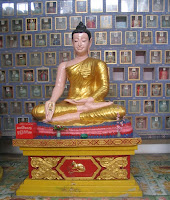 Pulau Pinang – Day 2 Gardens and Temples
Pulau Pinang – Day 2 Gardens and Temples We started our second day of touring with the assistance of Nathan, a taxi driver we had met the previous day. A native born citizen, Nathan added color commentary to our trip.
 The first stop was the beautiful Taman Botani, Botanical Garden. The garden, a short drive from Georgetown, is a peaceful sanctuary for walk
The first stop was the beautiful Taman Botani, Botanical Garden. The garden, a short drive from Georgetown, is a peaceful sanctuary for walk ers, runners, Tai Chi devotees and playful monkeys. We strolled the restful grounds visiting the Rumah Kaktus (cactus house) and Rumah Orkid (orchid house) as well as the Taman Formal (formal garden).
ers, runners, Tai Chi devotees and playful monkeys. We strolled the restful grounds visiting the Rumah Kaktus (cactus house) and Rumah Orkid (orchid house) as well as the Taman Formal (formal garden).
 Soon after departing we diverted to a nearby batik shop. Batik is an ancient Asian art form that uses wax and colored dyes to create beautiful artwork on fabric. Helen was educated in several ways to wear batik prints, with and without ties, and happily made a purchase of both.
Soon after departing we diverted to a nearby batik shop. Batik is an ancient Asian art form that uses wax and colored dyes to create beautiful artwork on fabric. Helen was educated in several ways to wear batik prints, with and without ties, and happily made a purchase of both.
Next on our sightseeing list was a “temple tour.” Although Islam is the predominant religion of the native Malays, Penang has a historic mix of Asian and European religions. The Thai temple of Wat Chayamangkalaram was our first stop. The temple was built in 1845 on land donated to the Thai community by  Queen Victoria. Greeting us at the temple entrance were two towering green-faced guards reminiscent of the giant statues we saw in the new Bangkok airport. The temple boasts of housing the world’s third largest Reclining Buddha. More research indicated that t
Queen Victoria. Greeting us at the temple entrance were two towering green-faced guards reminiscent of the giant statues we saw in the new Bangkok airport. The temple boasts of housing the world’s third largest Reclining Buddha. More research indicated that t he 33 meter resting Buddha is actually the 14th largest. Once inside the temple, Buddha ranking seemed irrelevant.
he 33 meter resting Buddha is actually the 14th largest. Once inside the temple, Buddha ranking seemed irrelevant.
 The reclining Buddha represents Shakyamuni Buddha at his death. Legend recalls that as death approached, the Buddha asked his disciples to prepare a couch for him in a grove. There he lay until he passed into nirvana. Not surprisingly, the temple houses a columbarium of the remains for former devotees who have also passed into nirvana.
The reclining Buddha represents Shakyamuni Buddha at his death. Legend recalls that as death approached, the Buddha asked his disciples to prepare a couch for him in a grove. There he lay until he passed into nirvana. Not surprisingly, the temple houses a columbarium of the remains for former devotees who have also passed into nirvana.
 Across the street from Wat Chayamangkalaram is the Dharmikarama Burmese Buddhist Temple. Consecrated in 1805, it was first Buddhist temple in Penang. The grounds of the temple which won the Penang State landscaping and beautification competition in 2001 are spacious and serene. The temple complex is filled with golden statuary and buildings.
Across the street from Wat Chayamangkalaram is the Dharmikarama Burmese Buddhist Temple. Consecrated in 1805, it was first Buddhist temple in Penang. The grounds of the temple which won the Penang State landscaping and beautification competition in 2001 are spacious and serene. The temple complex is filled with golden statuary and buildings.
Next on the temple tour was the Kek Lok Si Temple. The expansive temple is built on the east-facing hillside of Air Itam. Also known as the Temple of  Supreme Bliss, the temple has distinctively Chinese architecture, but has ties to both China and Thailand. The temple, constructed between 1893 and 1905, is currently under renovation. The towering ''Pagoda of Ten Thousand
Supreme Bliss, the temple has distinctively Chinese architecture, but has ties to both China and Thailand. The temple, constructed between 1893 and 1905, is currently under renovation. The towering ''Pagoda of Ten Thousand  Buddhas,'' once the main attraction, now stands in the shadow of the 120 foot bronze statue of Guan Yin Boddisattva. The 200 feet high pavilion roof that will enclose the enormous statue will be supported by 16 dragon pillars. We understand the true purpose of commemorating the Bodhisattva is to follow his spirit of practicing “Great compassion to all beings as one unit. Kindness to all beings without discrimination”. Amen…Shalom…May it be so.
Buddhas,'' once the main attraction, now stands in the shadow of the 120 foot bronze statue of Guan Yin Boddisattva. The 200 feet high pavilion roof that will enclose the enormous statue will be supported by 16 dragon pillars. We understand the true purpose of commemorating the Bodhisattva is to follow his spirit of practicing “Great compassion to all beings as one unit. Kindness to all beings without discrimination”. Amen…Shalom…May it be so.


 Pulau Pinang – Day 2 Gardens and
Pulau Pinang – Day 2 Gardens and 












0 Comments:
Post a Comment
<< Home